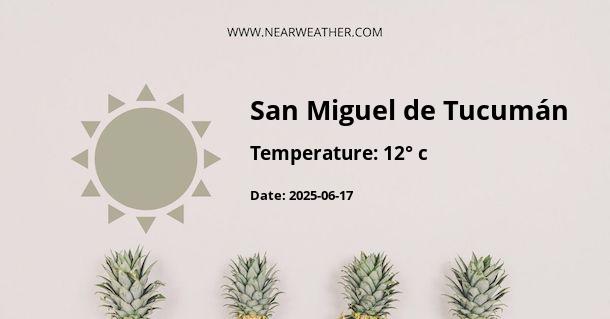Climate and Weather in San Miguel de Tucumán, Argentina
San Miguel de Tucumán, often simply referred to as Tucumán, is the capital of the Tucumán province in Argentina. The city is known for its rich history, beautiful landscapes, and diverse culture. Understanding the climate and weather patterns of San Miguel de Tucumán is essential for residents, tourists, and businesses operating in the region.
Overview of San Miguel de Tucumán's Climate
San Miguel de Tucumán enjoys a subtropical highland climate, characterized by mild temperatures, abundant rainfall, and distinct wet and dry seasons. The city experiences four distinct seasons: summer, autumn, winter, and spring. The climate is influenced by its elevation, geographical location, and the surrounding terrain.
Annual Weather Patterns
Let's take a closer look at the weather patterns that residents and visitors can expect throughout the year in San Miguel de Tucumán:
| Season | Average Temperature | Precipitation |
|---|---|---|
| Summer (December - February) | 25°C - 30°C | High rainfall, occasional thunderstorms |
| Autumn (March - May) | 18°C - 25°C | Moderate to high rainfall |
| Winter (June - August) | 10°C - 18°C | Low to moderate rainfall |
| Spring (September - November) | 15°C - 25°C | Moderate rainfall |
It is important to note that weather patterns can vary from year to year due to climatic anomalies such as El Niño or La Niña events.
Rainfall and Precipitation
San Miguel de Tucumán experiences a significant amount of rainfall throughout the year, with the wettest months typically occurring during the summer and autumn seasons. The city's proximity to the Andes Mountains and its elevation contribute to its substantial precipitation levels. The average annual precipitation in Tucumán is approximately 1,000 mm, with fluctuations between years due to climate variability.
Climate-Related Considerations for Visitors
For tourists planning to visit San Miguel de Tucumán, it's important to consider the climate when deciding the best time to travel. The summer months offer warm temperatures but also higher chances of rain, while the winter months are cooler and drier. Understanding the climate can help visitors pack suitable clothing and plan outdoor activities accordingly.
Impacts on Agriculture and Economy
The climate of San Miguel de Tucumán plays a significant role in the region's agriculture and economy. The city's ample rainfall and fertile soil support the growth of various crops, making it a vital agricultural hub in Argentina. The economy of the region is closely tied to agricultural production, and changes in weather patterns can have profound effects on crop yields and farming practices.
Climate Change and Adaptation Efforts
Like many regions around the world, San Miguel de Tucumán faces the challenges of climate change. Increasing temperatures, shifting rainfall patterns, and extreme weather events pose risks to the city's environment and infrastructure. Local authorities and organizations are undertaking efforts to adapt to these changes, including implementing sustainable agricultural practices and enhancing water management strategies.
Conclusion
The climate and weather of San Miguel de Tucumán significantly impact various aspects of life in the city, from agriculture to tourism. Understanding the seasonal patterns and precipitation levels is essential for residents and visitors to make informed decisions and adapt to the changing climate.
As Tucumán continues to evolve, it's crucial to monitor and address the effects of climate change, ensuring a sustainable and resilient future for the city and its inhabitants.
A - San Miguel de Tucumán's Latitude is -26.824141 & Longitude is -65.222603.
A - Weather in San Miguel de Tucumán is 19° today.
A - Climate Conditions in San Miguel de Tucumán shows light rain today.
A - Humidity in San Miguel de Tucumán is 94% today.
A - Wind speed in San Miguel de Tucumán is 5.54 km/h, flowing at 360° wind direction. today.
